I Watched the Bear Cam for Eight Hours Straight
by Shane Ferro
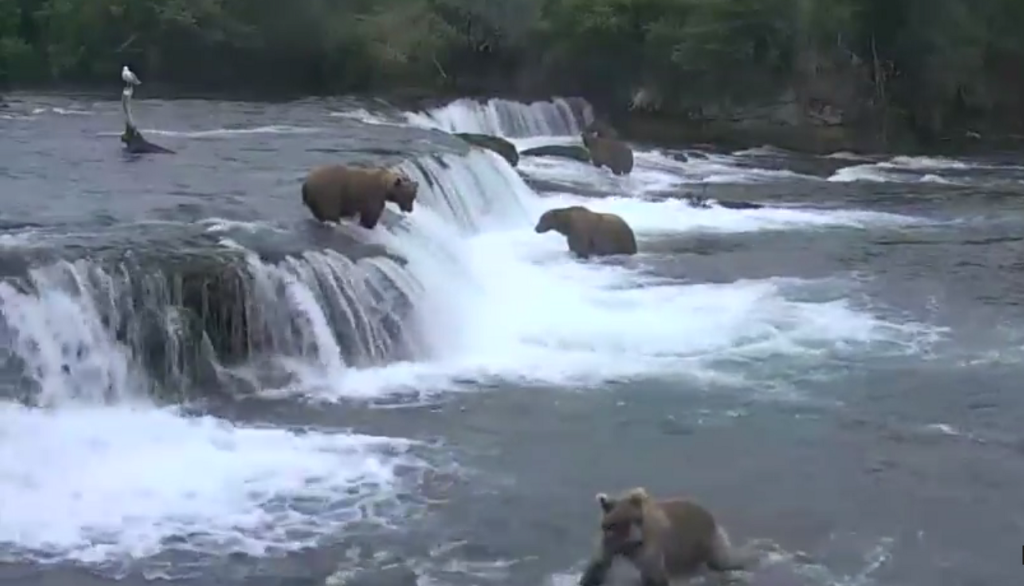
July 25, 2015
9:07 AM: I’ve committed to watching the bear cam for eight hours.
The bear cam is a National Parks Service-run twenty-hour live feed of one tiny section of Alaska’s Brooks River, where brown bears often are found hunting for salmon in the summer. The river is in Katmai National Park, which is nearly three hundred miles southwest of Anchorage, and pretty much only accessible by boat or plane. Or it was, before the bear cam.
9:08 AM: I never noticed there’s a still image that says “Live Cam” before you press play on the cam. This indicates that you are about to watch nature porn.
The camera moves occasionally, but inconsistently. It is mounted on the shore, and is usually trained slightly upriver on what is known as Brooks Falls, a waterfall that stretches across the river and is maybe five to ten feet high. Most of the time the bear cam’s view encompasses a maybe two-hundred-and-fifty-square-foot area that contains some the most popular bear fishing spots on the river. It looks like this:
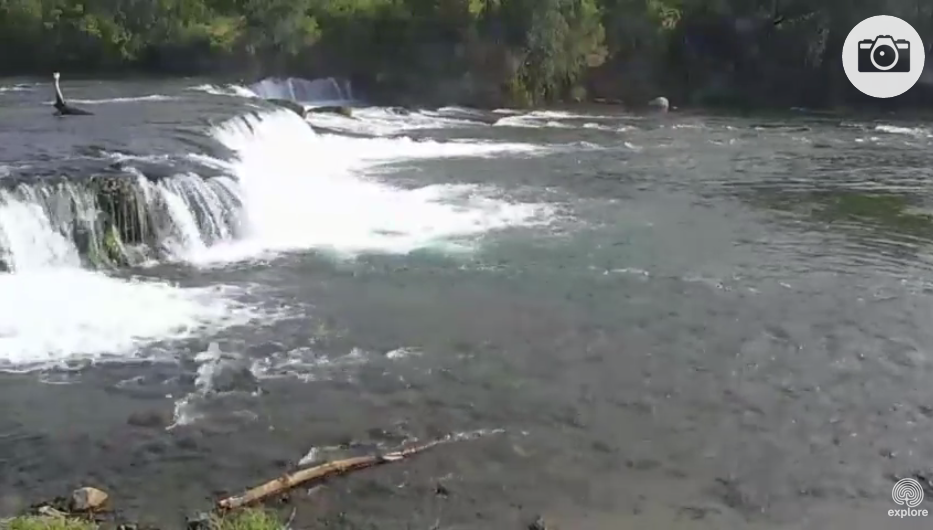
9:09 AM: Two bears, at the far end of the falls. (Update: Just one bear at the end of the falls. There was a rock that looked like a bear’s butt.) I like watching the falls without bears, though. It’s very soothing. One of the bears comes toward the camera, fighting through the rougher part of the river to get to shore. It succeeds, then wanders off.
Two of the best fishing spots are at the section of the falls closest to the camera — the lip, at the top of the falls, and the jacuzzi below it (so named by the National Parks Service), where water rushing off the lip creates a large area of foamy water. The far end of the falls is shallower and is known as the “far pool.” According to the NPS, bears that fish at the far end are often less tolerant of people, and stay away from the camera. As far as I can tell there is a camp and a park ranger station near where the camera is positioned.
Here’s what it looks like when bears are fishing on the lip, the jacuzzi, and the far pool all at once:
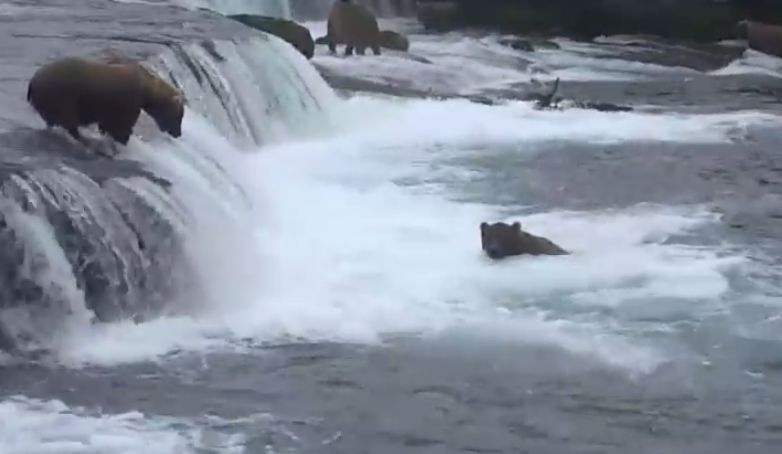
Sometimes — and it’s unclear whether this is done automatically based on movement or by hand — the camera will swivel downriver, where females, younger bears, and smaller or less aggressive male bears will fish. The camera also will sometimes zoom in on a bear, which makes me think it is done manually.
9:13 AM: Another bear has appeared at the top of the falls (although it is perhaps the bear who went to shore?)
9:16 AM: The bear caught a fish!
9:20 AM: The cam is black and white, which must mean that it’s still nighttime?
9:23 AM: I visited the National Park Service’s website, where there is more information on the bear cam. I learned that July is the best month to spot bears fishing for salmon (I’ve just made it, as it is currently the last week in July), although they are present from mid-spring to late summer. Brown bears are the only kinds of bears in Katmai National Park, although there was once a single sighting of a black bear. There is also an ebook specifically written on the bears of Katmai National Park. I have obviously just downloaded it.
9:31 AM: My coffee is finally ready. I’ve decided it would be festive to drink it out of my Teddy Roosevelt mug, as he is known for doubling the number of national parks in the system while he was president. (He became a conservationist after going on a buffalo hunting trip to the badlands, just as the species was about to go extinct.) Please do not ask me why I have a mug with Teddy Roosevelt on it.
9:41 AM: While I was writing about Teddy Roosevelt, the bear cam froze.
9:47 AM: According to Google, sunrise in Katmai is at 5:52 AM, which is in five minutes. I wonder when the camera changes from black and white to color.
9:56 AM: Sunrise has come and gone. Brown bears don’t care. One of the bears is dunking his head in the frothy water at the bottom of the falls.
10:14 AM: Four bears now! The real fishing day has begun. Still in black and white.
10:22 AM: And we’ve got color!
10:45 AM: At the top of the falls, one of the bears is going after the salmon. I have a feeling that things are about to get exciting; the bear slaps the water several times after failing to catch a fish. Pretty sure the bear is trying to trap the salmon between a rock and its paw, but in my mind he is throwing a temper tantrum. This is clearly the best fishing spot.
11:00 AM: This bear still hasn’t caught any fish. A bear at the bottom of the falls, though, is munching on something.
11:07 AM: The constant running water is very soothing, but that will make it hard not to fall asleep. The bear missed a fish again.
11:08 AM: Frozen, again.
11:18 AM: I’ve had a lot of technology trouble, but this bear is still at it, having a mild temper tantrum over not catching any salmon.
11:27 AM: MAJOR UPDATE: I ditched the iPad in favor of a computer, which I then ditched for the Roku box. All of them are frozen. I’m ready to say that this is a problem at the National Park Service level, not with my devices. Also, I’ve realized just how many devices I have in my apartment that allow me to stream YouTube.
11:34 AM: I am taking this opportunity to read the Washington Post’s profile of the painter Alex Katz. The beauty of the internet is that when one thing goes down there is always a replacement.
11:49 AM: In the continuing absence of the bear cam, I’ve been reading the Katmai National Park’s ninety-three-page ebook on the bears of Brooks Falls. So far I’ve learned that brown bears and grizzly bears are generally considered the same species, and the difference is only their geographic locations and food sources (grizzlies are further inland).
Also: Hearing and vision is estimated to be equivalent to humans, but a bear’s sense of smell, which is many times better than a dog’s, sets them apart. Bears use scent to communicate everything from dominance to their presence in an area to receptivity to mating.
11:52 AM: I miss the bears.
11:53 AM: THE CAM IS BACK.
11:59 AM: A BEAR CAUGHT A FISH. I REPEAT, A BEAR HAS A FISH. This is more or less because the fish jumped into his mouth, but I imagine that a bear will take what he can get. After fitting the fish into his snout, then sulked away onto the shore, out of view of the cam.
12:04 PM: The camera is now trained on the sole bear still out fishing, at the bank opposite the camera. This one is a dark brown-red, with bits of golden hair on the tips of his ears. I’ll call him Tippy. He’s just standing knee deep in the water below the falls, looking around for something to swim past. He doesn’t look like he’s close to catching anything, but he’s having fun. It’s more about the chase than the prize, right?
Ooh goes Tippy for a fish! He lunged, but came up bare handed.
12:08 PM: Lol puns.
12:10 PM: I would like to swim in the river. It’s hot in here. I’m also getting very hungry. I’ve decided if Tippy catches a fish, I’m going to make myself an omelette; I now have skin in the game here. Gooo Tippy go!
12:14 PM: The camera panned away and I can no longer see Tippy. I wonder if this means I can never eat again.
12:16 PM: The cam is frozen again. I guess I’ll eat lunch.
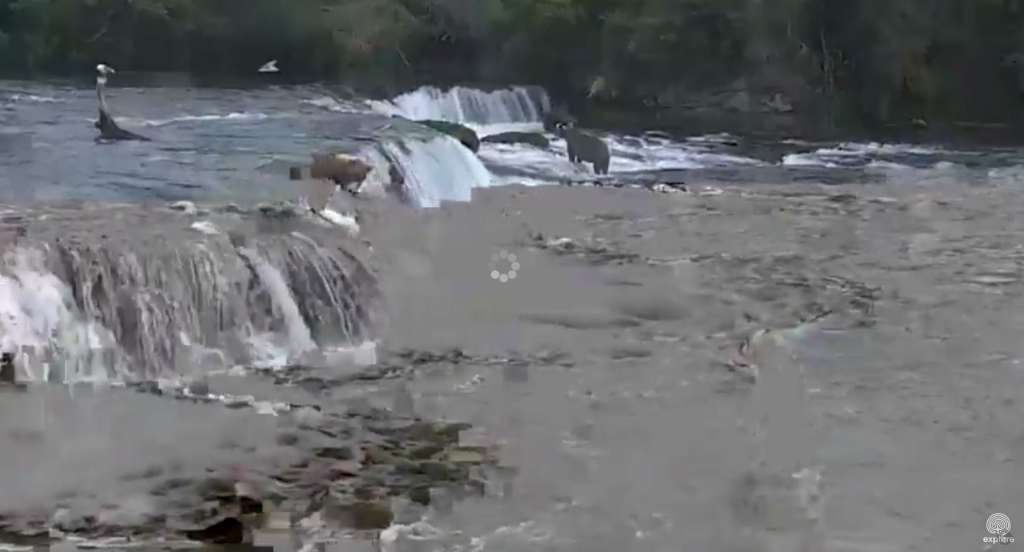
1:12 PM: After a half hour of staring at the cam as it constantly lurches from buffering screen to buffering screen, I’m starting to wonder if I should give up due to technical difficulties; I’ve reached the point where this has stopped being a novelty and become a test of endurance. I am not tired of the bear cam, exactly, I’m just starting to think of other things I could be doing, like going to Target or watching a meaningless sitcom I’ve already seen on Netflix, and I’m powerfully aware of how hot it is in my living room. There is a window unit AC, but it’s not powerful enough to cool the entire room. Perhaps I’m having a hot flash. Can you have a hot flash at twenty-six?
The bear cam is back, and has turned itself to the right to look further down river, where two bears are froclicking in a shallow rocky patch of the river. A couple hundred feet down river from the bears, there appear to be three men fishing mid-river. Just a couple hundred feet from a pack of bears. My boyfriend just yelled, “Get away from the bears!” (He’s here too.) I wonder if these fishermen are catching salmon that would otherwise go to the bears, because human jerks can leave nothing to the animals.
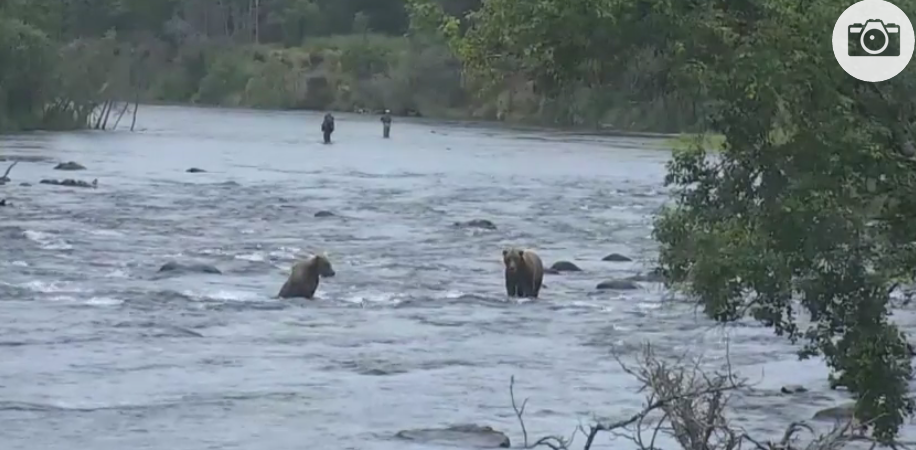
1:22 PM: These bears downriver seem smaller than the ones at the falls. I wonder if they are lady bears.
2:56 PM: I fell asleep. I’m awake now. The fishermen have moved further up the river, into bear territory.
2:57 PM: Definitely all men. Ban men.
2:59 PM: When the camera pans back and forth along the river you realize how little perspective you get on the bear cam. It’s easy to forget that this one little spot is just a tiny part of the river and forest that make up the bears’ habitat. You’re strangely looking at this crazy nature thing going on live thousands of miles away, and it’s more real than, say, an edited and packaged piece of “reality television,” but at the same time, the viewer’s perspective is limited to whatever angle the camera happens to be at. You see a limited version of what is going on at this place, but it is nothing like actually being there.
I wonder what Susan Sontag would write about Slow TV.
3:34 PM: Getting tired. Resorting to screenshots.
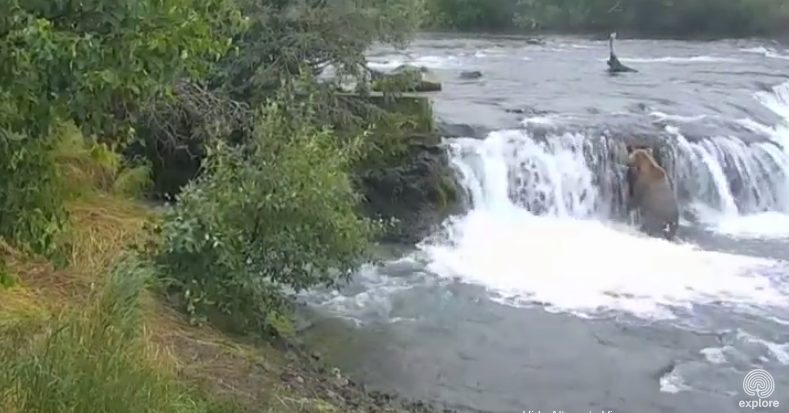
3:40 PM: Just realizing the name “bear cam” really ignores the large numbers of seagulls on the river. There are dozens of the rat-like sea birds around.
3:52 PM: Bear butt.
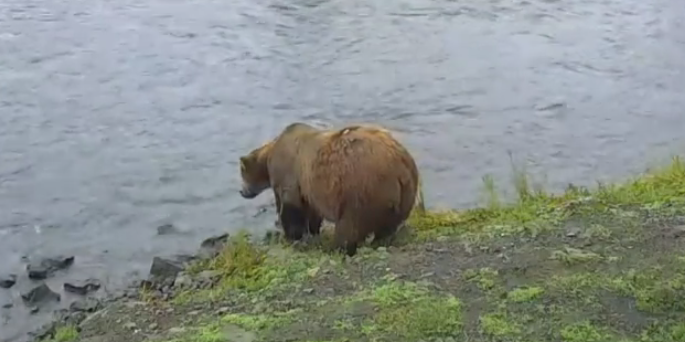
4:14 PM: I might be getting bored. I’m learning more about how the bears interact with humans as I make my way through the Brooks Falls bears ebook.
From Page 47:
#854 has learned to associate people with fish. In the lower Brooks River, she will often sit or lie on the shore while people fish nearby. She often looks like she is resting and not paying attention to the water, but when someone hooks a fish, she quickly enters the water in pursuit of an easy meal. Anglers should be especially careful around bears and remember that the sound of a splashing fish is the sound of food to a bear. Each time a bear takes a fish from someone’s fishing line it reinforces that behavior. The bear is then more likely to approach people in the future with the idea of obtaining food.
4:23 PM: The camera zoomed in on a bear who had caught a fish and was eating it on the shore. I learned why so many seagulls were around: Once the bear had enough, the seagulls began fighting each other for the fish scraps.
6:24 PM: Cub alert! three cubs playing in the grass! (This is technically outside the scope of the 8-hour livestream, but I tuned in again and THERE ARE CUBS!)
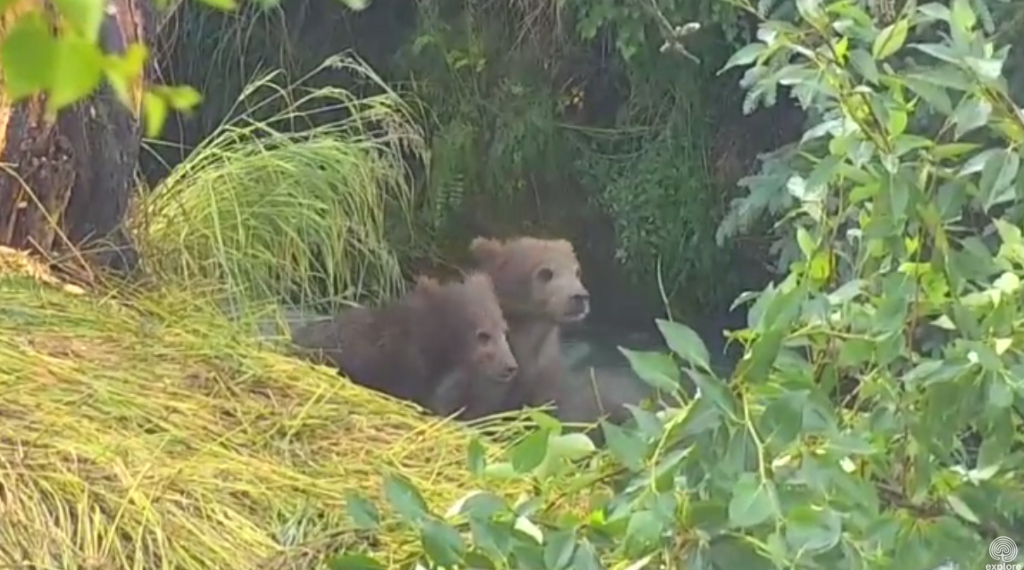
They went for a swim, now they are sitting down having a snack with mom.
